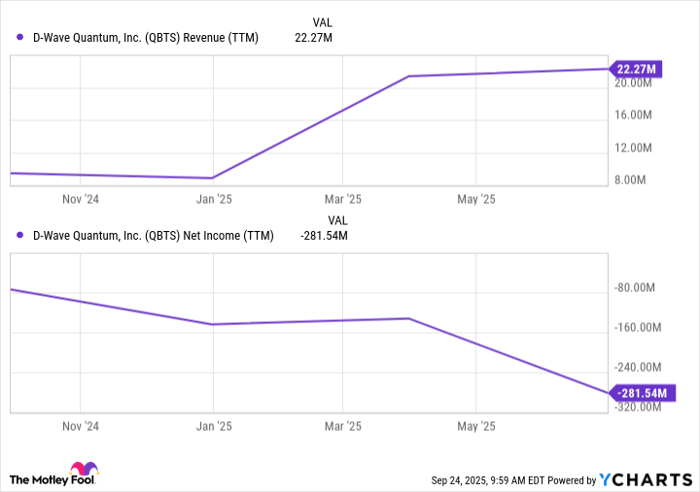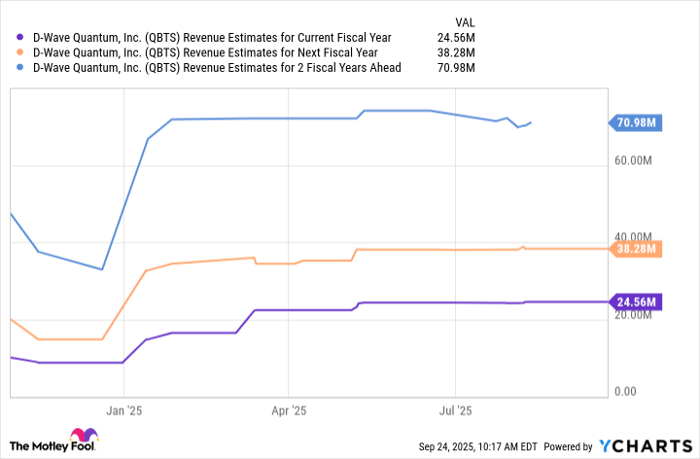Key Points
-
Quantum computing stocks are beginning to outpace AI’s largest players.
-
D-Wave Quantum has witnessed a meteoric rise over the last year thanks to a frenzy of retail buying.
-
D-Wave Quantum’s momentum may be tempting to follow, but the company’s progress remains limited and its valuation profile appears stretched.
- 10 stocks we like better than D-Wave Quantum ›
Quantum computing stocks are beginning to outpace AI’s largest players.
D-Wave Quantum has witnessed a meteoric rise over the last year thanks to a frenzy of retail buying.
D-Wave Quantum’s momentum may be tempting to follow, but the company’s progress remains limited and its valuation profile appears stretched.
The artificial intelligence (AI) revolution has ignited tremendous investor interest about which technologies could drive the next wave of growth for decades to come. Thus far, the most visible beneficiaries have been GPU designers like Nvidia, software platforms such as Palantir Technologies, and cloud infrastructure hyperscalers like Oracle.
However, as valuations in these well-established incumbents surge, many investors are beginning to search beyond the usual suspects. Increasingly, attention is shifting toward emerging applications — in particular, quantum computing. Quantum computing is a frontier technology promising to solve problems beyond the reach of today’s most advanced supercomputers.
Where to invest $1,000 right now? Our analyst team just revealed what they believe are the 10 best stocks to buy right now. Continue »
This sweeping potential has fueled a speculative frenzy around which companies might emerge as the leaders of quantum AI. For now, one of the most closely watched names is D-Wave Quantum (NYSE: QBTS), whose stock has skyrocketed 216% so far this year — far outpacing the broader S&P 500 and Nasdaq Composite, as well as many big tech companies.
QBTS data by YCharts
With D-Wave rapidly becoming a lightning rod for investor debate and the broader narrative around quantum mechanics, the key question is straightforward: Does D-Wave’s meteoric rise represent the dawn of a transformational opportunity, or is it just another bubble waiting to burst?
D-Wave’s growth is real, but there’s a catch
While quantum computing has captured intrigue, the reality is that its practical utility for AI remains limited today. Put simply, despite enthusiasm that quantum AI could one day revolutionize industries such as energy, financial services, and logistics, the technology is still largely in a research and development stage rather than delivering on its bold commercial ambitions.

QBTS Revenue (TTM) data by YCharts
These dynamics are on full display in the financial profile above. Over the past year, D-Wave Quantum generated just $22 million in revenue — with the vast majority of those sales concentrated in a single quarter. Such inconsistency highlights that market demand for quantum AI services remains thin and sporadic.
At the same time, losses continue to mount — accelerating at a pace that far outweighs the company’s modest top-line growth.
This matters because when management touts headline-grabbing growth rates — such as annual revenue expansion in the triple-digit range — the figures are inflated by a minuscule baseline. In other words, the law of small numbers is obscuring the reality of D-Wave’s fragile fundamentals.

Image source: Getty Images.
Smart investors understand D-Wave’s valuation is unsustainable
In the chart below, I’ve outlined Wall Street’s consensus revenue estimates for D-Wave over the next few years. Even if the company meets its 2027 projection of $71 million in sales, D-Wave would still be trading at an implied forward price-to-sales (P/S) ratio of 130, based on its current market capitalization of $9.2 billion.

QBTS Revenue Estimates for Current Fiscal Year data by YCharts
A multiple of this magnitude is unsustainably high, particularly for a company with persistent cash burn and no tangible path to profitable unit economics. So, what’s really happening here?
Much like many penny stocks that get caught in speculative cycles, D-Wave has become swept up in a momentum-driven rally fueled by hype over fundamentals. Even the slightest whiff of positive news tied to the broader quantum computing narrative — such as government funding initiatives — sparks frenzied buying from retail traders chasing hope rather than sustainable, compounding earnings power.
How can you invest in quantum AI?
While D-Wave will likely continue to attract its share of fanfare, investors seeking durable exposure to the quantum computing opportunity should look elsewhere.
The reality is that hyperscalers like Alphabet, Microsoft, and Amazon are all actively developing proprietary quantum processors — positioning themselves to benefit from the upside of commercialization once the technology matures. Meanwhile, Nvidia has extended its CUDA software architecture to run in hybrid classical-quantum environments, further reinforcing its technological moat.
For investors preferring a more passive, diversified approach, exposure to quantum AI is also possible through established blue chips like Honeywell, JPMorgan Chase, or Amgen — each of which own equity stakes in Quantinuum, a $10 billion quantum computing start-up.
The bottom line is clear: Quantum mechanics remains largely experimental, and investors need not chase hype-driven small caps to participate. There are far more credible avenues to gain exposure to this emerging frontier of AI as opposed to carrying the outsize risk of getting caught holding the bag in unproven, speculative contenders.
Should you invest $1,000 in D-Wave Quantum right now?
Before you buy stock in D-Wave Quantum, consider this:
The Motley Fool Stock Advisor analyst team just identified what they believe are the 10 best stocks for investors to buy now… and D-Wave Quantum wasn’t one of them. The 10 stocks that made the cut could produce monster returns in the coming years.
Consider when Netflix made this list on December 17, 2004… if you invested $1,000 at the time of our recommendation, you’d have $652,872!* Or when Nvidia made this list on April 15, 2005… if you invested $1,000 at the time of our recommendation, you’d have $1,092,280!*
Now, it’s worth noting Stock Advisor’s total average return is 1,062% — a market-crushing outperformance compared to 189% for the S&P 500. Don’t miss out on the latest top 10 list, available when you join Stock Advisor.
See the 10 stocks »
*Stock Advisor returns as of September 22, 2025
JPMorgan Chase is an advertising partner of Motley Fool Money. Adam Spatacco has positions in Alphabet, Amazon, Microsoft, Nvidia, and Palantir Technologies. The Motley Fool has positions in and recommends Alphabet, Amazon, Amgen, JPMorgan Chase, Microsoft, Nvidia, Oracle, and Palantir Technologies. The Motley Fool recommends the following options: long January 2026 $395 calls on Microsoft and short January 2026 $405 calls on Microsoft. The Motley Fool has a disclosure policy.
The views and opinions expressed herein are the views and opinions of the author and do not necessarily reflect those of Nasdaq, Inc.
#Meet #Monster #Quantum #Computing #Stock #Continues #Crush #Nvidia #Oracle #Palantir